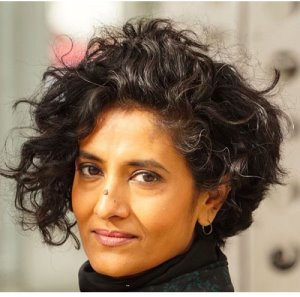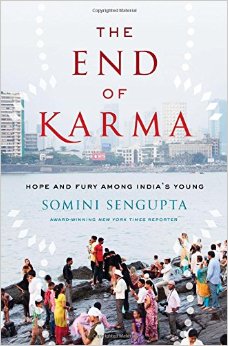TalkTime: Young, Indian, & Restless

(Photo: Nicole Bengiveno)
Somini Sengupta, the UN correspondent for The New York Times, observed India’s sociopolitical changes when she was the paper’s New Delhi bureau chief. In The End of Karma: Hope and Fury Among India’s Young, she writes about these shifts and discusses, through a series of portraits, the roadblocks India’s youth face as they push for the fulfilment of promises.
If you can think of one way the India of today is
different from say, even twenty years ago, what would
that one thing be?
India's youth bulge matters profoundly. Two-thirds
of the population is under age 35, and with fertility rates
falling sharply, India's share of young working-age citizens
is more important than ever before, for India and
the world. Indians under age 35 are the largest bloc of
the electorate, which means that politicians have to
address their demands at election time. The country
has to create economic opportunities for those who are
coming of age and joining the labor market each year—
an estimated 10 million a year—all at a time when the
world has made a compact to reduce carbon emissions
for our collective future. Young people's demands
are also forcing open new debates in law and social
mores, from lesbian and gay rights to stiffening penalties
against violence against women.

In your book you write, "India at noonday faces a
tougher test: how to make democracy something other
than topsoil." What do you mean by this statement?
Bhimrao Ambedkar perceptively described democracy
as "top dressing" on Indian soil, which
he said was deeply undemocratic because of caste
(to caste, I would add sex). Young Indians born
with one destiny are determined to make another.
That's a product of 70 years of democracy. Now, India
is being pushed from within to enable its young
people to realize their dreams, with some semblance
of equality of opportunity. Their demands come as
inequality grows quite visibly.
You write, “After the Ram Janmabhoomi movement
it became permissible to talk openly about a Hindu
nation.” Recently prominent Muslim celebrities have
spoken up about an atmosphere of intolerance. How
does this threaten the concept of secular India?
The sentence [that you quote] describes what my generation
of Indians told me about that pivotal moment. I
wasn't there myself. Every country has to decide for
itself what it means to be secular, and so secularism
in France is different from secularism in the United
States—and India, which has a long and remarkable
history of incorporating so many traditions over
hundreds of years, has found its own path as well. But
today, many ordinary Indians I know, whether Muslim,
Hindu, Sikh, or Christian, are repulsed when for instance,
a man is murdered on suspicion of eating beef.
It undermines the rule of law. It seems to have very
little to do with faith. I am a Hindu, and I should be able
to practice my faith in any modern, self-confident nation
without feeling threatened or without threatening
the life of others.
Prime Minister Modi rode this wave that followed
in the wake of the Ram Janmabhoomi movement.
How now does he do a balancing act to govern all of
India and keep the far right constituents at bay if you
will, and keep economic growth going?
Mr. Modi was decisively elected by a wide range
of voters. His chief challenge, in my view, is to address
the urgent needs of India's noonday generation:
improve health and education so they can be productive,
purposeful citizens, create economic opportunities
for them, and demonstrate a commitment to rule
of law, without which India cannot fulfill its potential.
In a democracy, the right and left and all those in
between should be able to express their points of view
freely. But if lawbreakers are not held accountable, this
undermines the very faith that Indian citizens have
in the laws of their land.
What parts of India feel foreign to you now?
Milky tea. I still can't drink milky tea. Thank goodness
for Barista and their excellent coffee!
The Facebook free speech story in the book is eyeopening.
How do you see this playing out in the future
as globalization increasingly delivers the world
to young Indians’ doorsteps?
I'm so glad you found it revealing. The people in
my book are mostly digital natives. They expect the law
to allow them to speak freely. And now, as you've seen
in the criticism of Facebook's offer of limited Internet
access, they also expect Internet companies to enable
them to access all of the Internet. I think free expression
in the digital era could be one of the main battlegrounds
for India in the coming years, and how India
handles questions of censorship and net neutrality
should be closely watched by others around the world.
You write that some people might think you emphasize
only the stories of the marginalized in the
book. Why did you decide to pick the people you did?
Because they are Indians, too, and I could have been
any of them: the maid who uplifts her entire family, the
stay-at-home-mom who helps here, the college girl
who sings Miley Cyrus covers, the Delhi woman who
follows her heart. Also, they are all remarkable in their
own ways. They are determined, they show incredible
resilience in the face of great odds, and
above all, they embody great hope for the
future of India.

Poornima Apte is a Boston-area freelance writer and editor. Learn more at WordCumulus.WordPress.com.
Enjoyed reading Khabar magazine? Subscribe to Khabar and get a full digital copy of this Indian-American community magazine.
blog comments powered by Disqus










